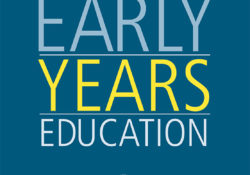tandfonline.com har udgivet en rapport under søgningen “Teacher Education Mathematics”: ABSTRACT ABSTRACT This research examined the role of touch in creative media production in the context of educational and community makerspaces. Touch, while only recently explored in digital media production, is a crucial perceptive sense through which to experience the world, particularly in two- and three-dimensional making, and to explore texture, temperature, and vibration. As an embodied experience through the hands, fingers, and other body parts, touch affords knowledge and agency. This paper describes research that investigated how students, ages 8–13, used touch to make media. The findings illustrate how different touch types—explorative, creative, auxiliary, evocative, orchestrated, and transformative – emerged as central to the students’ media practices for making products. These findings are important given the recent applications of… Continue Reading →
Like this:
Like Loading...
tandfonline.com har udgivet en rapport under søgningen “Teacher Education Mathematics”: ABSTRACT ABSTRACT Movement integration (MI) has become a significant part of contemporary educational policy; it implies that teachers of any school subject are responsible for organizing movement activities that are of educative value. In this paper, we use Wolfgang Klafki’s Bildung theoretical analysis to examine contemporary approaches to MI and clarify dominant theoretical and didactic ways of working with MI. We aim to suggest a new understanding of MI by applying Klafki’s conception of categorial Bildung. We argue that it enables educators to emphasize the educative and existential potential of the embodied, social and emotional involvement with the academic content. Our analyses illustrates the thorough didactic consideration needed to transform an educational policy into real-world education. Link til kilde
Like this:
Like Loading...
eric.ed.gov har udgivet: This paper contributes to the theory and evidence that mathematical cognition is embodied. Drawing on the practices of primary teachers in South Africa engaged in a longitudinal research and development project — Wits Maths Connect–Primary — we report on aspects of lessons aimed at developing number sense through whole-class teacher-learner interaction. Two episodes are analysed from an embodied cognition perspective. The episodes focus on helping Grade 1 (6-year-olds) learners become fluent in counting forward and back or ordering numbers. Analysis reveals different embodied metaphors underlie the teachers’ actions, the nature of which are likely to lead to different learning opportunities. We conclude that our analysis supports a theory of embodied cognition, and demonstrates its usefulness as an analytical tool. [For the complete proceedings, see ED597799.] Link til… Continue Reading →
Like this:
Like Loading...
tandfonline.com har udgivet en rapport under søgningen “Teacher Education Mathematics”: ABSTRACT ABSTRACT The present study examines adult–child touch and its functions in a Swedish preschool (for 1 to 5-year-old children). The data are naturalistic observations and video-recorded data of everyday preschool activities. The study describes the frequently occurring functions of educators’ haptic conduct (control, affectionate, affectionate-control, assisting and educative touch), discussing them in relation to the children’s age, gender and type of the preschool activity. It reveals the complexity of touch, demonstrating that physical contact is used for a variety of purposes in the educators’ daily work. The educators employed touch without force, and the children did not respond with explicit and forceful resistance (such as pushing back or otherwise protesting). Adult-initiated haptic behaviour served a continuum of social purposes… Continue Reading →
Like this:
Like Loading...


